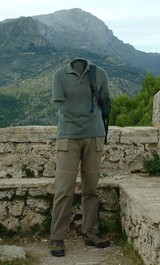The Proceedings of the Prehistoric Society No 61, 1996 pp 135 & 145
Page 135
"Is a substantial linear feature of no obvious function."
"May have been a land boundary of the kind associated elsewhere with the Neolithic / Bronze Age exploitation of upland areas."
Page 145
"A long straight flat-bottomed earthwork which does not conform to any lines of natural drainage or local topography. There is only limited evidence for banks on either side of the ditch"
|
I've just come across the following documentation. I think it may be the latest published survey and excavation report covering the Anglezarke area.
The Proceedings of the Prehistoric Society No 61, 1996
pp 133 – 166
"Seeing the Sites : Survey and Excavation on the Anglezarke Uplands, Lancashire"
By Christine Howard Davis
With contributions by
M. Bain, H. Bamford, B. Barnes, R. H. Leech & J. Quartermaine
|

The Anglezarke Moor Group has been created to collect together previously known sites and more importantly, new features that are appearing out of the eroding covering of peat.
The perimeter of this area have been defined using where possible landscape and are :-
West - Stronstrey Bank escarpment.
East - A675 (as it runs along the "valley" bottom between Turton & Anglezarke Moors)
South - The road from Belmont to Rivington village (as it runs at the base of Rivington Moor escarpment)
North - Dean Black Brook. (Separating Anglezarke from Wheelton Moor)
Over time it may be decided that some of these should not be considered in "isolation" but may be linked to other sites in the surrounding area.
As features are rediscovered they probably won't appear on any maps and so may not be named. In cases like this I suggest they are named Anglezarke Misc 1, 2 etc until a proper naming convention is found.
|
|
Like King Orry's Grave, the Cloven Stones are situated in the garden of a bungalow and has suffered building development.
|
|
A rescue excavation in 1988 revealed important assemblages of Neolithic and Beaker pottery and worked flint but structural features.
|
|
Excavation in 1989 revealed evidence of tempory shelters indicating a late Mesolithic occupation site.
|
|
The name Tynwald is derived from the old Norse 'Thing-wald' - 'Assembly Field'
|
|
Site of an Iron age promontory fort that once contained various embankments and buiding foundations. A house has now been built in the middle of the site.
|
|
This Iron Age promontory fort contains of a group of structures, both round and rectangular. At least 40 cup markings in 12 different locations have been found within the the enclosure, and others found on the outcropping rocks in the vicinity.
|
|
The site shows evidence of Norse re-occupation of an earlier Iron age promontory fort during the 10th & 12th C.
|
|
The inner rampart was probably the earliest phase of construction dating from the late Bronze Age, but the date of the outer rampart is unclear. It is suggested that the whole site continued to be occupied into the early Iron Age.
|
|
The circular structure was initially interpreted as a stone circle but now is recognised as a round house probably dating to the Iron age. But due to the presence of the stone outlier its original layout as a stone circle cannot be dismissed.
|
|
Following its excavation in 1941-44 by G. Bersu, Ballacagen has become the type-site for roundhouses on the Isle of Man.
|
|
The site was excavated in 1913 by P.M.C. Kermode and showed that the visible keeill was built into a Bronze age mound.
|
|
The site consists 3 mounds. During field walking activities many flints have been found suggesting a Bronze age date for the complex.
|
|
The site comprises a massively constructed cist 1.8m X 1.1m set in the remains of an irregular mound.
|
|
The site comprises a chamber 1.6m X 0.7m internally, open to the east side and is surrounded by a setting of stones 3m square.
|
|
The site was partially excavated by P. M.C. Kermode in 1926 and found that the western side and end had at an earlier time been quarried into for building stone.
|
|
Hi,
Born, bred and still live in Lancashire.
Been interested in Local History & Archaeology all my life'
Spent most of my teenage years 'rooting around Anglezarke'. If you live up here you'll know where I mean.
Member of Leyland Historical Society
http://www.houghton59.fsnet.co.uk/Home%20Page.htm
Member of Lancashire Archaeological Society
http://mysite.freeserve.com/LAS_1
Currently involved in the Lancashire Place Name Survey and tracking down Tenon top Gate Posts. If you don't know what these are check out my web page.
http://lancs99.blogspot.com/
|
|

